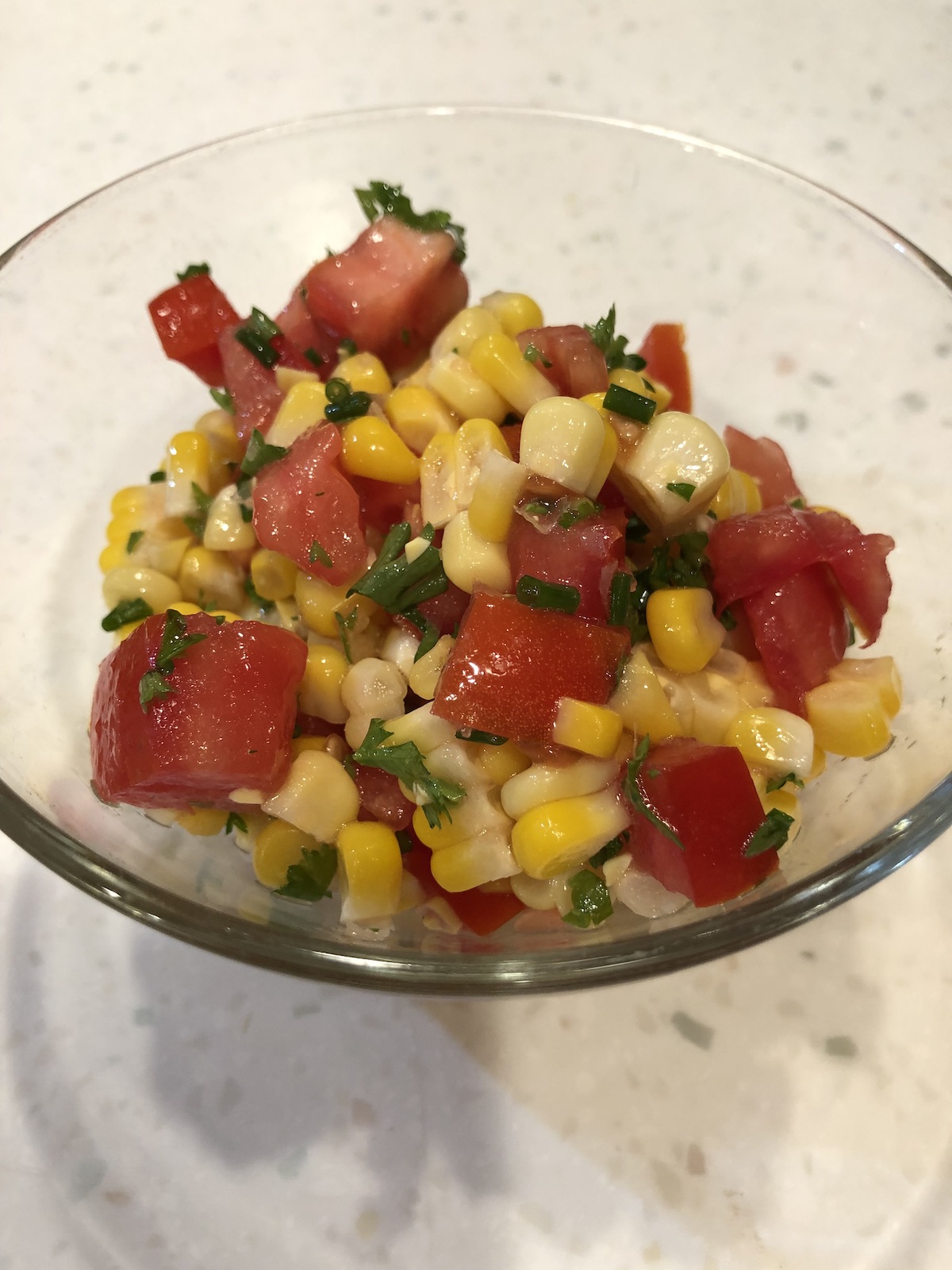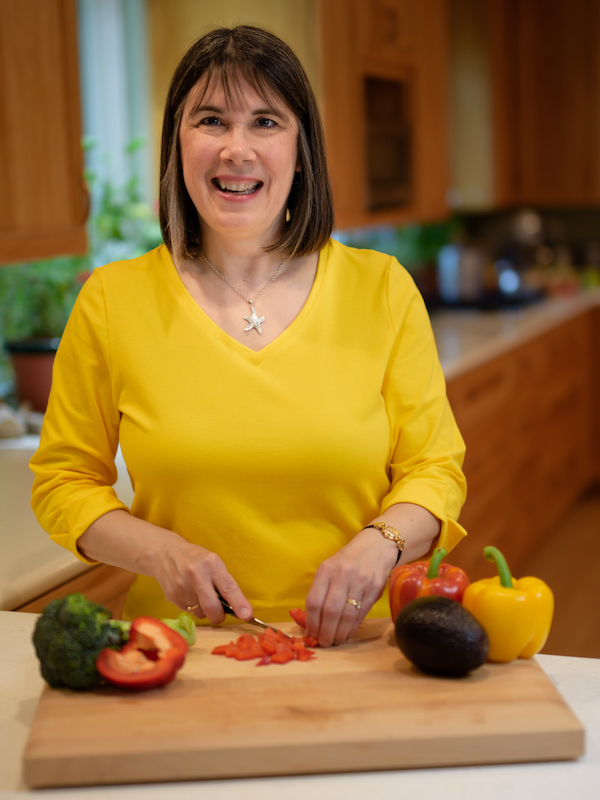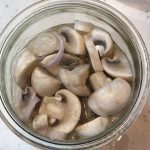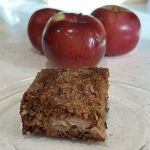
The Cooking Framework Quiz is available by clicking the button below.
Don’t miss an episode!
The button below will take you to Apple Podcasts to subscribe.
Or visit your favorite podcast provider to subscribe.
Thank you!
Transcript
Welcome to The Sensitive Kitchen. Where home cooks are inspired to Cook to Enable Those You Love to Flourish.
I’m Cindy Sullivan, registered dietitian, passionate nutrition educator, and accomplished home cook. Whether you’re changing how you cook for food sensitivities, allergies, intolerances, or just trying to eat healthier on a budget, you’re in the right place. Most episodes, I will share favorite recipes as well as modification tips, and nutrition benefits. Occasionally I’ll have a guest or special episode like modifying holiday favorites.
My favorite foods? They’re raspberries and homemade chocolate chip cookies. My latest cooking project was long fermented sourdough bread.
Happy August! I hope your summer has been fabulous so far. My time away from the podcast and blog in July was refreshing and full of wonderful family times.
My cousins and uncle came to Michigan to start the month. We headed to family camp at Cedar Bay. All four of us were there and it was glorious. Dear brothers and sisters in Christ who we have known for many years and time, both in God’s word and His unspoiled wilderness were refreshing to my soul.
Ten days in Bay View with my mom and daughter were highlighted with a beautiful Memorial for my Dad. I miss him regularly. I am so thankful for the sure promise of heaven for those of us who belong to Jesus.
Coming home has been filled with watching my husband, Tim, play baseball and the Olympics. And summer produce and more Olympics.
I have been waiting to share summer produce recipes with you ALL year! This month is full of corn, tomatoes and zucchini. So let’s get started.
For today’s nutrition tidbit, we’re going to talk about sweet corn. Sweet corn is among the top vegetables consumed in the United States. Canned and frozen sweet corn is ranked third among vegetables consumed in the U S, only behind canned tomatoes and frozen potatoes.
The four main categories of corn are field, popcorn, sweet and ornamental, a wonderful article in Science Digest, (which I will link to in the show notes) states that previously, phytochemicals of corn have received less attention than those of fruits and vegetables. The consumption of corn and other whole grain products has been linked to the reduce risk of chronic diseases, including cardiovascular disease, type two diabetes obesity, some cancers, and with the improvement of digestive tract health. The health benefits of whole grains have long been underestimated.
Wait a minute. This quote talks about the health benefits of whole grains. Is corn, a vegetable or a whole grain?
The answer actually is both.
With different varieties and different maturities, corn has different nutrient profiles, but both are in the sweet corn category, not popcorn, field, or ornamental corn.
So I did a bunch of research for this podcast, but it was hard to tell how much of the research was applicable to sweet corn, because it’s hard to determine which of the antioxidants there are abundant in sweet corn are fully developed in the ears of corn that we eat as a vegetable.
As many of you are aware, the sugar in sweet corn changes over to starch during storage. And for this reason, I recommend using sweet corn on the cob to make this recipe and not corn from the freezer section of your grocery store. However, that’s only about taste, not nutrient content, but as the corn matures, the nutrient content also changes.
I will summarize some of the research on corn like this: whole corn deserves a place in your diet. It’s filled with phytochemicals, meaning plant chemicals that are good for your health, like total phenolics and phenolic acids, which are different than many found in other fruits and vegetables.
The good news is, is that the heat treating of these corn products actually allows many of these antioxidants to be released from their bound state so that they’re better absorbed by your digestive tract. So purchase corn meal, whole grain corn meal that is, and other corn products made from whole grain and enjoy!
Two notes on this:
First of all, popcorn falls into this category. It is a whole grain as well. It appears to have the same antioxidant benefit as other types of corn. Some experts are concerned, however, about the possibility of harmful chemicals in the packaging of microwave popcorn. So do be careful here.
The second note is that corn starch and corn syrups are certainly not whole grains and do not have any health benefits.
What can I tell you about the nutrient content and possible benefits of sweet corn, fresh ears of sweet corn, specifically contrary to much of what you may have heard, sweet corn is actually a nutritious vegetable and deserves a place on your plate.
To dispel some of the myths about sweet corn, let’s compare it to an apple. For comparison sake, we’ll take 100 grams, (which is about three and a half ounces) of each food.
A hundred grams of corn has about 20 calories more than an apple. A hundred grams of corn has half the sugar and about three grams more total carbohydrate than a hundred grams of apple. Both have about the same amount of fiber, but more of the fiber is insoluble. You need both kinds.
Well, apples have virtually no protein. Corn has about three and a half grams of protein in a hundred grams of sweet corn. So if you eat apples – and I recommended you do – make room for corn on your plate!
in terms of antioxidants and other phytochemicals, we do know that corn is loaded with lutein and zeaxanthin. These are both carotinoids, but they do not have vitamin A activity in your family like beta-carotene does.
Instead Healthline summarizes it, wonderfully this quote by them,
“Lutein and zeaxanthin are the only dietary carotinoids that accumulate in the retina, particularly in the macular region, which is located at the back of your eye. The macula is essential for vision. Lutein and zeaxanthin work as important antioxidants in this area, protecting your eyes from harmful free radicals. It’s thought that a reduction of these antioxidants over time can impair eye health”
This could possibly lead to conditions such as age related, macular degeneration, cataracts, diabetic retinopathy, and more.
In your eyes, lutein and zeaxanthin also act as a natural sunblock by absorbing excess light energy. They’re thought to especially protect your eyes from harmful blue light.
In addition to your eyes, lutein, and zeaxanthin may also have skin benefits: acting as antioxidants to help prevent ultraviolet light damage, reducing inflammation and improving skin tone.
In addition to corn, dark green vegetables, such as kale, spinach and broccoli are also good sources of lutein and zeaxanthin. And so are egg yolks.
Let’s get back to corn. They’re loaded with lutein and zeaxanthin, or it is, but in terms of vitamins and minerals, corn is a good source, (which by a good source, I mean at least 10% of your daily recommended intake) of the B vitamin folate and the minerals, magnesium, phosphorus and potassium while being low in sodium.
Well, corn does not rival broccoli or spinach in nutrient content. In addition to the vitamins and minerals listed above it’s a great source of carbohydrate fiber, protein, and it does contain health promoting antioxidants that are good for you.
So grab a bowl, grab a knife and make some Fresh Corn Tomato Salad. Make your body and your mouth happy!
Culinary summer has arrived! Fresh tomatoes and sweet corn are here. Besides just eating them plain, steamed or raw the salad. It is one of my favorite ways to combine them. Plus it keeps well in the refrigerator and it’s a great picnic staple.
Another benefit of the salad is that for those family members, with braces or other dental challenges that make eating corn on the cob difficult, I recommend this salad.
Let’s talk about ingredients and substitutions. As long as you can eat corn and tomatoes, it is allergy and sensitivity free. The ingredients are corn, tomatoes, chives, or possibly green onions,parsley, red wine, vinegar, oil and salt.
One ingredient can make or break this salad. I suggest you don’t make it with Pompeian brand red wine vinegar. Several years ago, Cook’s Illustrated rated store-bought red wine vinegar. Pompeian brand came out on top and it makes a big difference in how your recipe tastes. (The other winner was spectrum 365 by Whole Foods, but I’ve not tried that one.) I also use to make this salad with homemade raspberry vinegar, and it is excellent. I highly recommended if you have some in your house.
I do strongly recommend you make this salad when corn on the cob andtomatoes are at their in season peak.
But honestly, I have used both from the grocery store at this time of year with good results. Just use the right brand of red wine vinegar.(Pompeian) And no I’m not making any money from them. I should buy stock!
While large potatoes, excuse me while large tomatoes are preferred, if you have cherry or grape tomatoes use those. If you prefer cilantro to parsley, feel free to substitute. I use chives from my garden and if you’re local and you need some, let me know – our backyard is full of chives. But if you don’t grow chives, use green onions.
Let’s talk a little bit about preparation. The salad calls for steamed corn cut off the cob. The first time I made the salad, I was kind of hesitant to cut the corn off the cob. Would it be hard? How much time would it take?
The good news is that with a sharp knife, it’s quick and easy. As usual, you can find the recipe at foodsensitivitykitchen.com/episode032 as well as many pictures, including pictures of me cutting the corn off the cob. So like I said, the good news is with a sharp knife, it is quick and easy to cut the corn off the cob.
You want to aim to remove most of the corn kernel without cutting into the cob. The kernels are caught either on a cutting board or a plate. And don’t worry if the kernels stick together, they’ll break apart as you gently mix the salad.
Now you have a choice. You get to choose whether you want to cut the corn off the cob before you steam it or after. Either works just fine.
Here are a couple of reasons you might prefer one method or the other. You will want to consider cutting the corn off the cob after it’s cooked if you don’t have a vegetable steamer, that’s easy to clean. Or if you have leftover corn from dinner that you want to use for this salad.
You want to consider cutting the corn off the cob after it’s cooked if you don’t have a frying pan, large enough to cook all the corn at one time, or if you want an easier time cleaning the pot.
Cook the corn. I usually use a large skillet in about an inch of boiling water. Cover it. And while you let the corn cool, you chop the tomatoes, parsley, chives, or green onions and make the dressing. Cut the corn off the cob and place it in a bowl.
Or for the second method, you can cut the corn off the cobs. Place the corn in a steamer basket and steam for about three minutes. Put the corn in a bowl. While the corn cools, chop your tomatoes, parsley, and chives and make the dressing. Combine all the vegetables and stir gently.
Whisk the dressing and pour about three quarters of the dressing over the salad. Because ears of corn and tomatoes may differ a little bit in size, it’s hard to know exactly how much dressing you’ll need. This salad has a lot of liquid, both the dressing and from the tomatoes. I recommend serving it in a bowl with a spoon so all the yummy juices can be eaten.
You do NOT want this salad to be dry. If you don’t have several tablespoons of liquid in the bottom of your serving bowl, add the rest of the dressing.
The salad takes a few more minutes than just steaming the corn or slicing tomatoes and plunking them on the table, but it is worth it. We’ve eaten it for years in our house. Plus if you’re lucky, you’ll have leftovers for a couple of lunches.
Enjoy cooking with fresh produce! Go to the farmer’s market and buy something new.
I will be back in two weeks to talk about what to do with all the tomatoes you either grew in your garden, or you purchased at the farmer’s market. Remember the recipe can be found at foodsensitivitykitchen.com/episode032. Have a wonderful day. Thank you so much for joining me today and enjoy your summer!
Have a great day. Bye-bye.
References
AskUSDA
U.S. DEPARTMENT OF AGRICULTURE
https://ask.usda.gov/s/
Cash in on the health benefits of corn
Mayo Clinic Health Systems TUESDAY, AUGUST 14, 2018
https://www.mayoclinichealthsystem.org/hometown-health/speaking-of-health/cash-in-on-the-health-benefits-of-corn
Food Science and Human Wellness
Volume 7, Issue 3, September 2018, Pages 185-195
https://www.sciencedirect.com/science/article/pii/S2213453018301009
FoodData Central USDA DATABASE
Lutein and Zeaxanthin: Benefits, Dosage and Food Sources
Written by Sharon O’Brien MS, PGDip — Updated on July 11, 2018
https://www.healthline.com/nutrition/lutein-and-zeaxanthin
Processed Sweet Corn Has Higher Antioxidant Activity
VERONICA DEWANTO,† XIANZHONG WU,† AND RUI HAI LIU*,†,‡
J. Agric. Food Chem. 2002, 50, 4959−4964 4959
Department of Food Science and Institute of Comparative and Environmental Toxicology, Stocking Hall, Cornell University, Ithaca, New York 14853
http://ucce.ucdavis.edu/files/datastore/608-134.pdf
The World’s Healthiest Foods
http://www.whfoods.com/genpage.php?tname=foodspice&dbid=90




